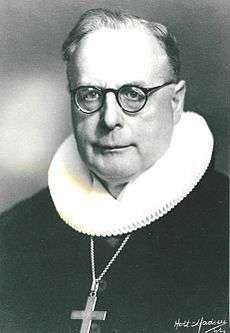Hans Fuglsang-Damgaard
Hans Fuglsang-Damgaard (29 July 1890 – 8 July 1979) was a bishop of the diocese of Copenhagen for 25 years including the years of the German occupation.
The Right Reverend Hans Fuglsang-Damgaard | |
|---|---|
| Bishop of Copenhagen | |
 Hans Fuglsang-Damgaard | |
| Church | Church of Denmark |
| Diocese | Diocese of Copenhagen |
| In office | 1934–1960 |
| Predecessor | Harald Ostenfeld |
| Successor | Willy Westergaard Madsen |
| Personal details | |
| Birth name | Hans Fuglsang Damgaard |
| Born | July 29, 1890 Fuglsang, Oksenvad parish, Germany |
| Died | July 8, 1979 (aged 88) Lyngby, Denmark |
| Buried | Sorgenfri cemetery |
| Nationality | German, then Danish |
| Parents |
|
Biography
Hans Fuglsang-Damgaard was born 29 July 1890 in Fuglsang, Oksenvad parish to proprietor Mikkel Lauritzen Fuglsang-Damgaard and wife Bodil Marie Helene née From and baptized Hans Fuglsang Damgaard in Oksenvad church on the fourteenth Sunday after Trinity. At the time Oksenvad was part of Germany and Fuglsang-Damgaard was thus part of the Danish population in German Northern Schleswig.[1][2]
During World War I Fuglsang-Damgaard was drafted into the German army and served on the Western front where he became a prisoner of war in France.[2]
As Danish bishop he was primus inter pares and during the later stage of the occupation notably outspoken against the German occupiers.[3] He is especially known for his pastoral letter denouncing the Nazi antisemitism as irreconcilable with Christianity, signed by all bishops in Denmark and read out during the services on 3 October 1943,[2] following the German attempt to capture and deport the Danish Jews.
After the liberation, on 29 August 1945 bishop Fuglsang-Damgaard led the state funeral of 106 killed members of the Danish resistance, and thus inaugurated the cemetery that would later become Ryvangen Memorial Park at the site where the remains of the resistance members had been exhumed.[4]
Fuglsang-Damgaard was decorated with several classes of the Order of the Dannebrog.[2]
References
- "Fødte Mandkøn" [Born Males]. Kirkebog [Parish Register]. 1885–1935 (in Danish). Oksenvad Sogn. 1890. p. 19. 20.CS1 maint: location (link)
- Schjørring, Jens Holger. "H. Fuglsang-Damgaard". denstoredanske.dk (in Danish). Retrieved 30 May 2015.
- "Modstandsdatabasen" [Resistance Database]. Hans Fuglsang-Damgaard (in Danish). Copenhagen: Nationalmuseet. Archived from the original on 30 May 2015. Retrieved 30 May 2015.
- "Historie - Mindelunden Ryvangen" [History - Ryvangen Memorial Park] (in Danish). Ministry of Ecclesiastical Affairs. Archived from the original on 29 November 2014. Retrieved 30 May 2015.